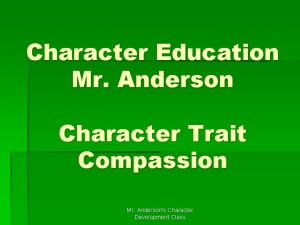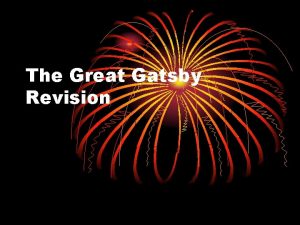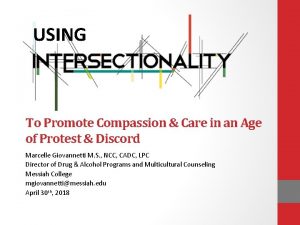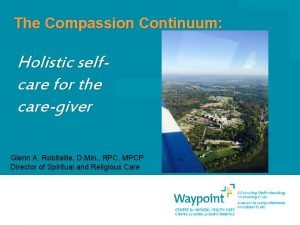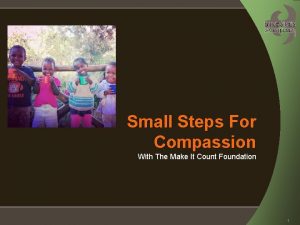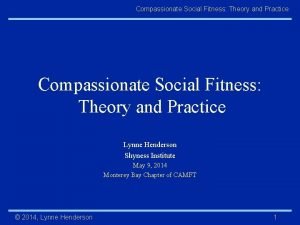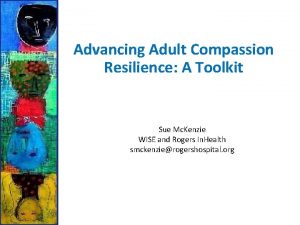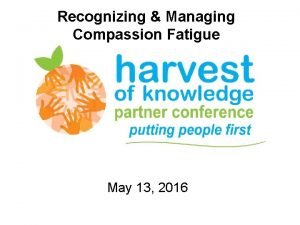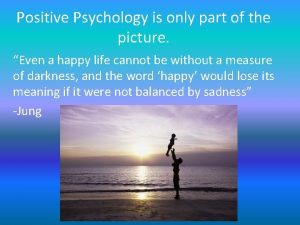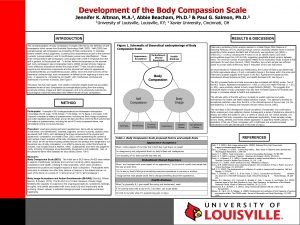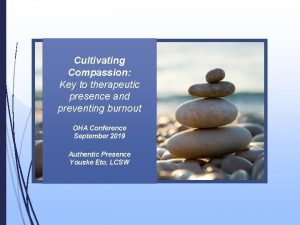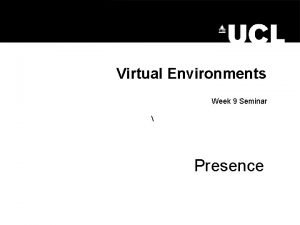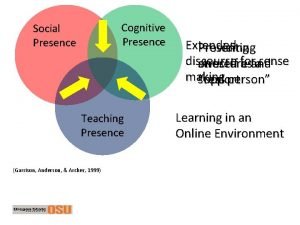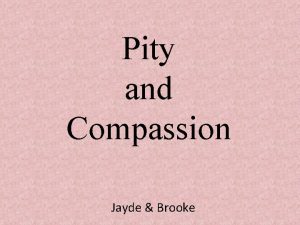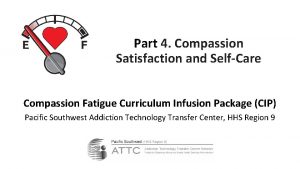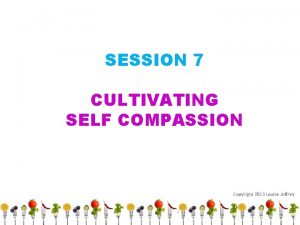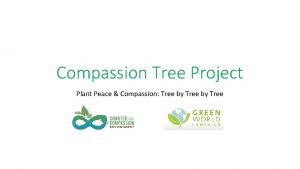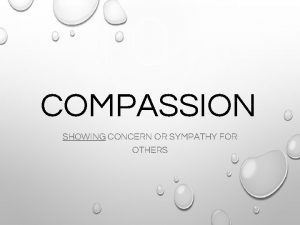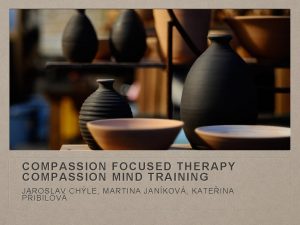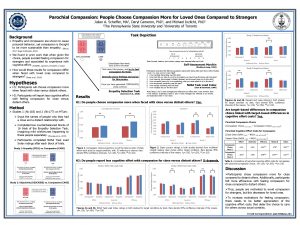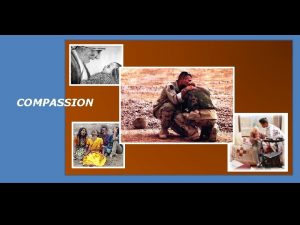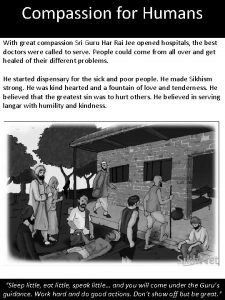Cultivating Compassion Key to therapeutic presence and preventing





























- Slides: 29

Cultivating Compassion: Key to therapeutic presence and preventing burnout OHA Conference April 2017 Spiritual Care Program Youske Eto, LCSW

“Real care of the sick does not begin with costly procedures, but with the simple gift of affection and love. In the practice of healing, a kind heart is as valuable as medical training, because it is the source of happiness for both oneself and others. People respond to kindness even when medicine is ineffective, and in turn cultivating a kind heart is a cause of our own good health. ” - His Holiness the Dalai Lama

“No words of comfort can reach the parents or take away their pain when they lose their baby. I kept asking myself, What can I offer when nothing else can be done? I was trained to do, to fix. . . I felt helpless and inadequate. ” `Dr. Angela Anderson, Hasbro Children’s Hospital

Witnessing suffering is itself a true experience of suffering Tania Singer, Ben Seymour, John O’Doherty, Holger Kaube, Raymond J. Dolan, Chris D. Frith, “Empathy for Pain Involves the Affective but not Sensory Components of Pain, ” Science 303, 1157 (2004).

Are we better off distancing ourselves from the pain and suffering of our patients?

Research shows that physicians who have a strong emotional connection with their patients have a lower risk of burn-out. Kearney, M. K et al. , Selfcare of Physicians Caring for Patients at the End-of-Life. JAMA, 2009, 301(11), p. 1284 -1293.

The secret to building resilience and to responding more effectively = Cultivation of compassion combined with mindful awareness Bernhardt, B. C. , & Singer, T. (2012). The neural basis of empathy. Annu Rev Neurosci. doi: 10. 1146/annurev-neuro-062111 -150536 ● Klimecki O. M, Leiberg S, Ricard M, & Singer T. (in press). Differential Pattern of Functional Brain Plasticity after Compassion and Empathy Training. Social Cognitive Affective Neuroscience. ●

The basic premise of the contemplative approach: ● The contemplative approach is not about equipping ourselves with yet another new set of ‘techniques’. ● It is about uncovering and strengthening what is already there within us: the natural capacity to be present, to be kind and compassionate. ● The contemplative approach integrates methods such as mindfulness, awareness meditation and training in deepening our natural capacity for empathy.

The basic premise of the contemplative approach: ● These contemplative methods come from the Buddhist tradition and are offered in a secular, open and authentic way. ● These methods have been the subject of research in major universities, including Harvard and Stanford in the US, or the Max Planck Institute in Germany. ● They have inspired the emerging field of “contemplative neuroscience” (the study of the effect of contemplative practice on the brain).

Prominent Research Centers • University of Wisconsin has been studying a group of Tibetan monks to see what effects their meditation practice has on their brains, as measured by f. MRI. • Emory University have investigated the effects of compassion meditation on the body’s systemic responses to psychosocial stress. • University of Texas have established a Self-Compassion Research Lab and are investigating both the effects of self-compassion and possible methods for training people, mainly schoolchildren, in selfcompassion. • University of California at Berkeley, the Greater Good Science Center is researching into the roots of compassion and altruism. • Standford University, the Center for Compassion and Altruism Research and Education is creating a community of neuroscientists, psychologists, educators and philosophical and contemplative thinkers around the study of compassion. • Max Planck Institute of Human Cognitive and Brain Science in Germany is increasing our understanding of human social behavior related to compassion.

Where does the contemplative approach start? The contemplative approach starts with ourselves. Why? When we are with our patients or clients, what communicates the most, and has the greatest impact, is not what we say or do, but how we are - the quality of our presence, our authenticity and genuine compassion, and confidence.

How we are

Three Key Aspects • Cultivating mindfulness and awareness through meditation • Cultivating compassion for self and others through compassion training • Personal embodiment of compassionate care through contemplative listening and communication

Compassion

Differentiating Sympathy, Empathy, and Compassion

“When your fear touches someone’s pain it becomes pity; when your love touches someone’s pain, it becomes compassion. ” - Stephen Levine

“We can think of empathy as the characteristic of a very warm hearted person and well-meaning person: reason as that of someone who is very practical, intelligent and wise. When we put the two together, the combination is highly effective. ” ~ The Dalai Lama

“Compassion means letting go of your selfidentity. Compassion means you work in the way the wind works, the sun works, or the air works. Take, for example, how the air assumes the shape of the room. The air does not say, “I will give you this breathing space provided you breathe way I want. ” Everyone enjoys the benefit of being able to breathe in the air. It is the same way with the sun: the sun does not stop shining when there are clouds in the sky. ” - Khandro Rinpoche

Empathy Empathetic Distress Negativity; Withdrawal Compassion Feeling of Concern Positivity; Resolve to Help Olga Klimecki, Tania Singer research, Max Planck Institute

Neuroscience indicates that there is no such thing as "compassion fatigue”, but rather "empathy fatigue" that can be remedied by cultivating compassion.

Training in compassion begins with laying the foundation: Cultivating compassion for ourselves. When we come in touch with our own sense of wholeness and wellbeing, we are more readily able to see and relate to the wholeness/goodness of others.

Self-Compassion

Loving Kindness Practice

“For clinicians, the Contemplative End of Life Care program is training in the fundamentals of therapeutics - listening with our heart open, being fully attentive, fully present. By deepening our contemplative practice we deepen our professional practice. ” MD ~ Dr. Ira Byock,

“The more we can learn to ‘just be’, the more we can reflect a sense of ease, comfort, and wholeness back to those we care for. We can become like a mirror, reflecting back their goodness, ease, and wholeness. The way we talk to patients and clients, the way we touch and gaze at them, the whole quality of our presence, can make them feel understood and remind them of their sense of purpose and meaning, - make them feel whole. “ - Kirsten De. Leo

Benefits – Contemplative Care Approach • Increased self-awareness and self-acceptance • Decreased levels of stress, anxiety and depression • Better self-care (burnout prevention) • Greater capacity to be present with suffering and manage difficult situations • Enhanced effectiveness • Enhanced relationships with patients • Greater sense of connectedness with colleagues and teams • Greater job satisfaction and sense of purpose

To sum up: shift from “doing” to “being. ● Training in mindful awareness and compassion allows us to shift from ‘doing’ to ‘being’. ● Making this shift can not only help us to create supportive environment where our patients/clients can find their own healing, but also be deeply nurturing for us as clinicians.

Questions and Answers

Thank You
 Chapter 24 lesson 2 preventing and treating stds
Chapter 24 lesson 2 preventing and treating stds Chapter 9 resolving conflicts and preventing violence
Chapter 9 resolving conflicts and preventing violence Chapter 14:2 preventing accidents and injuries
Chapter 14:2 preventing accidents and injuries Chapter 9 resolving conflicts and preventing violence
Chapter 9 resolving conflicts and preventing violence Chapter 13:2 preventing accidents and injuries
Chapter 13:2 preventing accidents and injuries Benefits of self compassion
Benefits of self compassion Compassion fatigue signs
Compassion fatigue signs Compassion fatigue vs burnout
Compassion fatigue vs burnout Everyone needs comoansion
Everyone needs comoansion Ted talk compassion fatigue
Ted talk compassion fatigue Compassion character trait
Compassion character trait Compassion fokuseret terapi øvelser
Compassion fokuseret terapi øvelser The american dream examples in the great gatsby
The american dream examples in the great gatsby Project compassion 2016
Project compassion 2016 Compassion care counseling
Compassion care counseling Compassion continuum
Compassion continuum Small steps for compassion
Small steps for compassion Definiton of compassion
Definiton of compassion Splagchnizomai
Splagchnizomai Everyone needs compassion the kindness of a savior
Everyone needs compassion the kindness of a savior Peter stevenson compassion in world farming
Peter stevenson compassion in world farming Too much compassion
Too much compassion Breast
Breast Health and fitness: theory and practice
Health and fitness: theory and practice Compassion resilience toolkit
Compassion resilience toolkit There is neither greek nor jew
There is neither greek nor jew Since
Since Compassion fatigue definition
Compassion fatigue definition Self compassion mantra
Self compassion mantra Body compassion scale
Body compassion scale










